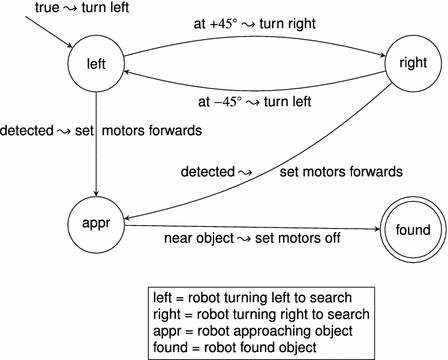
- Fizzi to draw finite state automata how to#
- Fizzi to draw finite state automata pro#
- Fizzi to draw finite state automata code#
- Fizzi to draw finite state automata series#
| An圜har (* An圜har matches a string "c" for any c *) | Char of char (* Char(c) matches a string "c'" iff c = c' *) Regular expressions, which is our internal representation of patterns. The following datatype definition defines the abstract syntax for Here is another implementation of regular-expression pattern matching It turns out that the SML/NJ library includes aįunctor RegexpFn that provides the functionality for you.
Fizzi to draw finite state automata how to#
InĬS381/481 you'll learn how to efficiently construct finite automataįrom regular expressions. Of how much time is needed to construct the finite automaton. That contains A! This does beg the question Whether the entire text matches the regular expression, but we can easilyīuild a regular expression that allows the given regular expression to
Fizzi to draw finite state automata code#
String matching algorithms we saw earlier! Note that this code simply checks String, which makes it asymptotically similar in run time to the simple The run time of this loop is clearly O( n) in the length of the text If pos = String.size(text) then Array.sub(accept,state) *) fun search1(pos: int, state: int): bool = * returning whether it accepts the rest of the string. *) fun next_state(pos: int, state: int): dest =Įlse let val char = Char.ord(String.sub(text, pos)) inĮnd (* Walk the DFA down the string "text" from position "pos", * state "state" and the next character is text. | Error (* if no next state *) type DFA = : DFA, text: string): bool = let (* Give the next state of the DFA, assuming that it is in State of state (* Edge destination is another state *) Type state = int (* Note: 0 is the start state *) datatype dest = Implementing pattern matching for regular expressions using For example, the automaton on the right can be written as this The pair (current state, input character) to the next state of theĪutomaton. To the more complex regular expression a(b*|bcb) note that it hasĪ DFA can be implemented very easily using a table. For example,Īn automaton that accepts the same strings as the regular expressionĪb* is shown on the left the automaton on the right corresponds It is conventional to draw finite automata as a graph where the states areĭrawn as circles and the accept states are drawn as double circles. State, it has seen a string matching the pattern. For each inputĬharacter, it follows the single outgoing edge from the current state Start state and scans the text from left to right. Node labeled with a particular character. Is a distinguished start state and some number of accept states.įinite automaton, there is at most one outgoing edge from any given The edges of the graph are labeled with characters, and there Graph in which the vertices (nodes) are the states of theĪutomaton. It's the Greeks'įault.) A DFA, also known as a finite state machine, is a finite Is the singular, "automata" is the plural. Length of the string! (For those who care about language: It turns out that for any regular expression, a deterministicįinite automaton (DFA) can be constructed that recognizesĪny string that the regular expression describes in time linear in the Patterns we saw earlier, they can be efficiently searched for in a larger They are particularly useful because, like the simple string Regular expressions provide an expressive language for describing
Fizzi to draw finite state automata pro#
The template "UML state machine diagram" for the ConceptDraw PRO diagramming and vector drawing software is included in the Rapid UML solution from the Software Development area of ConceptDraw Solution Park.Recitation 26: Regular expressions and finite automata CS 312 Recitation 26 Protocol state machines express the legal transitions that a classifier can trigger." It specifies which operations of the classifier can be called in which state and under which condition, thus specifying the allowed call sequences on the classifier’s operations. Protocol state machine is a specialization of behavioral state machine and is used to express usage protocol or lifecycle of a classifier. During the traversal, the state machine could also execute some activities.
Fizzi to draw finite state automata series#
Transitions are triggered by the dispatching of series of events.

The state machine formalism used in this case is an object-based variant of Harel statecharts.īehavior is modeled as a traversal of a graph of state nodes connected with transitions. The following nodes and edges are typically drawn in state machine diagram: behavioral state, behavioral transition, protocol state, protocol transition, different pseudostates.īehavioral state machine is specialization of behavior and is used to specify discrete behavior of a part of designed system through finite state transitions.


Two kinds of state machines defined in UML 2.4 are: State machine diagrams can also be used to express the usage protocol of part of a system. "State machine diagram is a behavior diagram which shows discrete behavior of a part of designed system through finite state transitions.


 0 kommentar(er)
0 kommentar(er)
